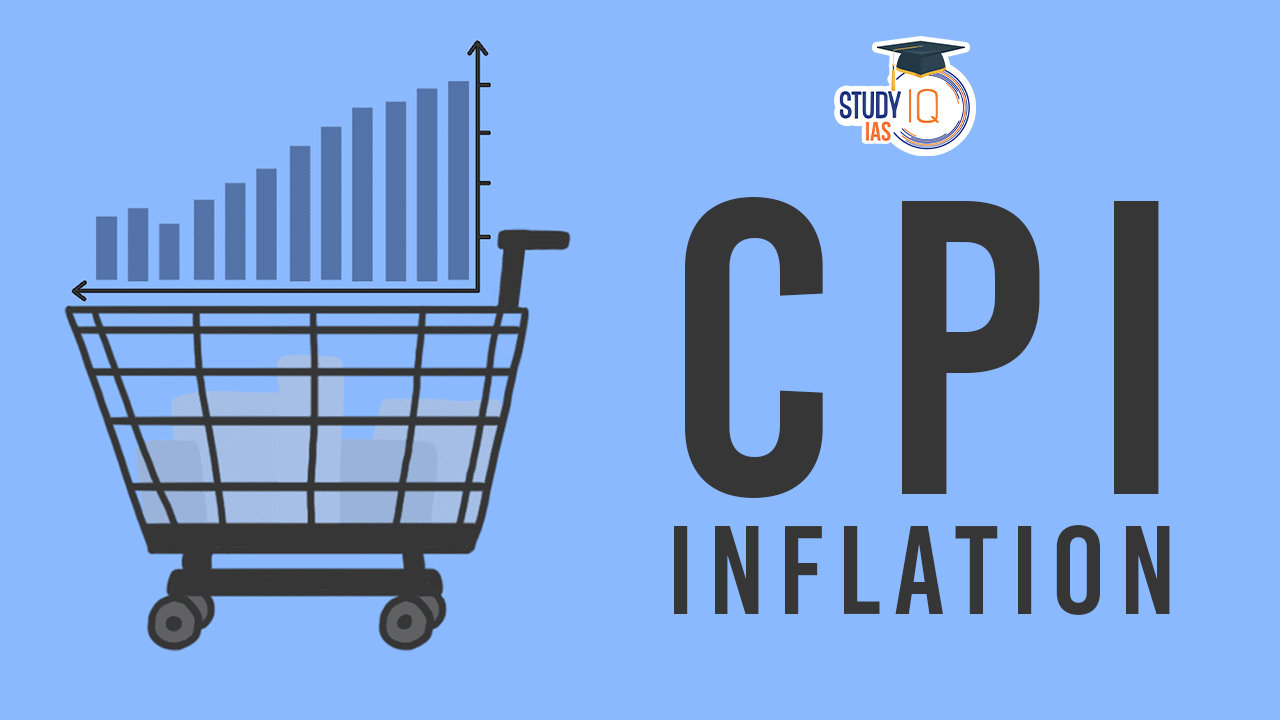Table of Contents
Context: India’s retail inflation declined to a near six-year low of 3.16% in April from 3.34% in March, according to data released by the National Statistics Office (NSO).
What Is CPI Inflation?
- The consumer price index measures “changes over time in the general level of prices of a basket of selected goods and services that households acquire for consumption.” – Ministry of Statistics and Programme Implementation (MoSPI).
- CPI Inflation is released monthly by the National Statistical Office (NSO), Ministry of Statistics and Programme Implementation (MoSPI).
- At an all-India level, the current CPI basket comprises 299 items.
What is Meant by Retail Inflation (CPI-Based Inflation)?
- Retail Inflation refers to the rate at which the prices of goods and services consumed by households increase at the retail level over a period of time.
- It is measured by the Consumer Price Index (CPI).
- CPI tracks the price changes in a fixed basket of essential items such as food, clothing, housing, transportation, education, etc.
- When prices rise, it indicates inflation.
- When prices fall, it indicates deflation.
- CPI tracks the price changes in a fixed basket of essential items such as food, clothing, housing, transportation, education, etc.
Uses of Retail Inflation (CPI-Based Inflation)
- Policy Decision-Making (Monetary Policy): The Reserve Bank of India (RBI) uses retail inflation data to set interest rates and control inflation through its monetary policy.
- Inflation Targeting: The Government and RBI use CPI as the official inflation target metric (currently 4% ± 2%) under the Inflation Targeting Framework.
- Wage and Pension Adjustment: CPI is used to adjust salaries, wages, and pensions to maintain the real income of employees and pensioners against rising prices.
- Measuring Cost of Living: CPI reflects the cost of living and purchasing power of consumers, making it useful for understanding economic well-being.
- As a Deflator in National Accounts: CPI is used to convert nominal values to real values (e.g., real GDP), helping to isolate the effect of inflation from economic growth data.
- Economic Health Indicator: It serves as a barometer of the economy, indicating whether inflation is under control or if corrective steps are needed.
How Is CPI Inflation Calculated?
- Base Year: It is a reference point used for comparison to measure changes in price levels over time. The current base year is 2012.
- The price index is given a value of 100 for 2012, and changes from these price levels are then calculated to arrive at inflation rates for each good or service.
- According to the National Statistical Office within the MoSPI, the monthly price data is collected from 1181 villages and 1114 urban markets spread all across the country.
- The data for this purpose is collected weekly by the field staff of NSO.
What Are the Components of CPI Inflation?
The Consumer Price Index (CPI) comprises six primary categories, each with different importance and various subcategories. These main components are:
- Food and Beverages: This is the most significant section, accounting for 45% of the total index. Within this, cereal prices are particularly influential, making up 67% of the CPI.
- Pan, Tobacco, and Intoxicants: This category includes items like pan, tobacco products, and various intoxicants.
- Clothing and Footwear: This segment covers all types of apparel and footwear items.
- Housing: This component reflects costs associated with housing, such as rent.
- Fuel and Light: This includes expenses for energy sources like electricity and fuel.
- Miscellaneous: This diverse category encompasses services like education and healthcare, and it’s the second most significant component after food and beverages.
Analysing Inflation Rates
The analysis of inflation rates can be approached in two distinct ways:
- Year-on-Year (YoY) Increase: This method involves comparing the price level of a given month (e.g., December) with the price level in the same month of the previous year (e.g., December of the last year).
- The resulting rate is the year-on-year increase. This is the most common way to calculate inflation.
- Month-on-Month (MoM) Change: This calculation compares the prices of one month (e.g., December) with the prices in the preceding month (e.g., November).
- Recent data indicates that while the year-on-year inflation rate rose towards the end of 2023, the month-on-month data for December showed deflation.
- Deflation: It is the term used to describe a situation where prices drop from one period to the next.
- It is important to note that deflation is different from disinflation, which refers to a slowdown in the rate of inflation from one month to another.
- Regarding the various components of inflation, a significant rise in food prices was responsible for the increase in year-on-year inflation in December. Specifically:
- Vegetable prices surged by nearly 28% compared to December 2022.
- Pulse prices increased by 21%, and spices by 20%.
- Cereal prices also went up by 10%.
- These four food groups alone, which represent 23% of the total CPI weight, were key drivers in the overall inflation rate increase.
- Finally, inflation rates continued to vary across different regions of the country. Odisha recorded the highest inflation at 8.7%, while Delhi experienced the lowest at 2.9%.
Significance and Concerns Of Recent Data
Significance
- Inflation Outlook: Analysts predicted a decline in inflation rates in the coming months, attributing this to factors such as the Kharif harvest and government measures aimed at reducing food inflation.
- Annual Inflation Projection: For the entire financial year, inflation is expected to average around 5.5%, with March 2024’s inflation rate forecasted to be about 5%.
- Core Inflation Trend: Even as overall inflation fluctuates, the core inflation rate (which excludes food and fuel prices) has been on a downward trend.
Concerns
- Impact on Monetary Policy: The recent uptick in inflation, particularly in November and December, is likely to postpone any reduction in interest rates, affecting loan EMIs.
- Previously, there was speculation that the RBI might cut rates as early as April, but now rate cuts are not expected before August.
- RBI’s Stance: The Reserve Bank of India (RBI) is cautious about the secondary effects of food price volatility on achieving policy objectives.
- Experts believe that the RBI will maintain its current stance on monetary policy and rates, potentially leading to only a modest rate cut starting in August 2024.
- Challenges for Fiscal Policymakers: Rising inflation poses difficulties for fiscal policymakers. This includes political challenges due to the proximity to elections, and the complications it brings to budget planning, where uncertainty around inflation is problematic.
We’re now on WhatsApp. Click to Join
Difference between WPI & CPI
| Feature | Wholesale Price Index (WPI) | Consumer Price Index (CPI) |
| Definition | Measures average changes in prices at the wholesale level for goods and services. | Measures average changes in prices at the retail level for a basket of consumer goods and services. |
| Released By | Office of Economic Advisor, Ministry of Commerce & Industry. | National Statistical Office (NSO), Ministry of Statistics and Programme Implementation. |
| Coverage | Primarily covers goods only, focusing on manufacturing inputs and intermediate goods. | Covers both goods and services, including food, housing, transportation, and medical care. |
| Base Year | 2011-12 | 2012 |


 World Population Day 2025, Themes, Histo...
World Population Day 2025, Themes, Histo...
 Special Intensive Revision (SIR) in Biha...
Special Intensive Revision (SIR) in Biha...





















